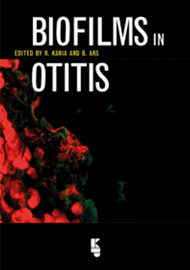If you haven’t already heard of biofilms, this book will tell you that they are multicellular networks of bacteria encased in a matrix, a complex multidimensional biologic fortress that protects bacteria against changes in the environment, host immune responses and antibiotics. Their role in middle ear disease is immense.
Forgive me for digressing when I’ve barely begun, but I must tell you about a beautiful little book, Stalkers of Pestilence by Wade W Oliver, published in 1929. It describes, in glorious detail, the development of understandings about infectious disease over time. From early chapters on Hippocrates and Galen, to ‘modern’ chapters on Louis Pasteur and Lord Lister, this delightful tome tells us everything that was known about bacterial infections at the time, except of course, how to treat them effectively. In what is perhaps a tragic irony, this book went to print at the same time as Alexander Fleming announced his discovery of penicillin in the Journal of Experimental Pathology.
I have a feeling that Biofilms in Otitis may be the Stalkers of Pestilence of its time. Published in hardback and with renowned names on its contributor list, this book describes, in glorious detail, everything that is known about biofilms, except of course, how to treat them effectively, because this is yet to be discovered. Its 17 chapters each have an executive summary, which largely conclude that further work is required. One chapter concludes that until a medical treatment for biofilms is discovered, surgical management remains at large. Whilst this is perhaps reassuring for the otologists among us, it also makes us tentatively question our futures.
Both books represent an intelligent and inquisitive body of research and knowledge, teetering on the brink of a great discovery, which will change the way we understand and practise medicine, forever.





